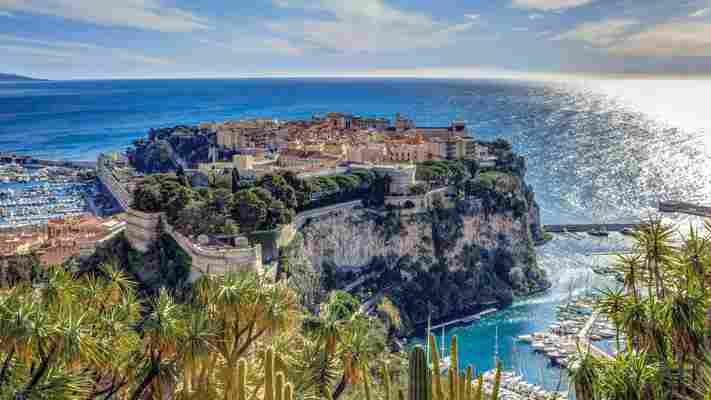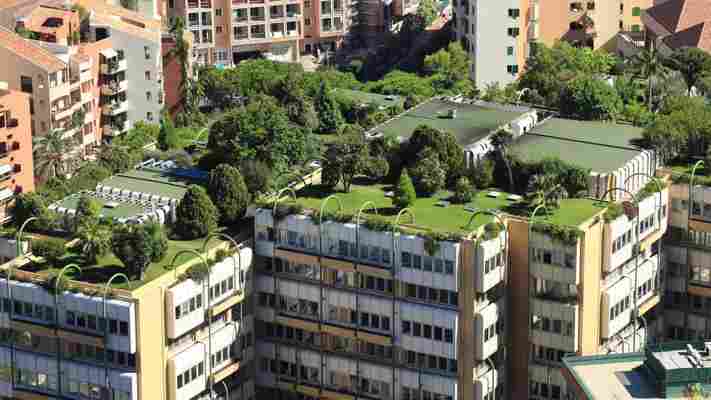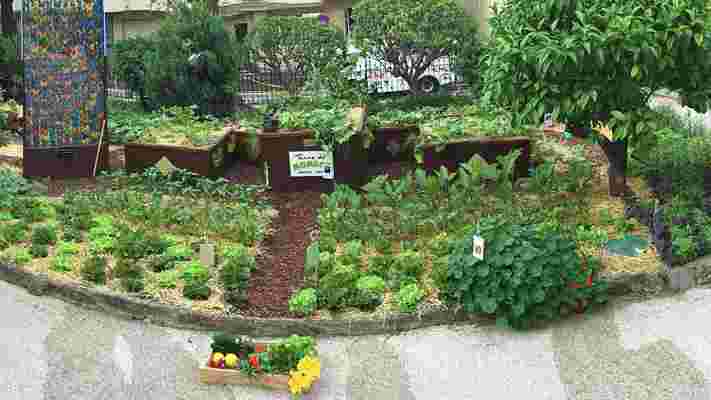The glitzy European city going green
It’s an unlikely spot for an organic fruit and vegetable garden, tucked away between soulless high-rise buildings that dot the most densely populated country in the world. But this 450 sq m sliver of land is where market gardener Jessica Sbaraglia toils away. It’s a lush slice of tranquillity in Monaco’s concrete jungle, lying in the shadow of the 170m-high Odéon Tower , the principality’s tallest building, which is also home to the most expensive penthouse in the world – €300 million (about £255 million), should you have the cash to splash.

Sbaraglia, a 31-year-old Swiss native and former tennis pro and model, launched her urban agriculture business Terre de Monaco in 2016 and she now has five micro farms on Monaco’s rooftops, balconies and hidden plots of land. At this one, my taste buds are treated to a multitude of flavours from the garden, which grows everything from aubergines and courgettes to strawberries and apricots. “I want people to reconnect with the taste of natural, organic produce, and remind them of its diversity and how it’s grown,” Sbaraglia explained.

Urban gardening has been reclaiming rooftops and concrete spaces throughout Monaco (Credit: vuk8691/Getty Images)
With 1,600 sq m of potagers (gardens) that have produced 5 tonnes of organic produce since 2016 and partnerships with chefs of Michelin-starred restaurants, Terre de Monaco is a local success story. But Sbaraglia says she experienced pushback when she started out. “At first, everyone laughed at me, told me that I’d fail, that the project would never work,” she recalled. “Monaco is mostly concrete; I didn’t think I’d find the room. I really needed to convince people.” And now, I ask? “Everyone seems to be playing the [eco] game; they’re more engaged now. But there’s still room to grow – many rooftops are still empty, so there are plenty of possibilities.”
You may also be interested in: • Living in a country that thinks green • Why the French don't show excitement • Barack Obama on why travel matters
Sbaraglia is just one of many in Monaco helping to drive a change towards sustainability. The country may be associated with glamour and excess – from hedonistic frolics on a superyacht to a flutter in the grand casinos – yet this corner of the Côte d’Azur is, surprisingly, emerging as a leader in environmental responsibility. Beneath its sparkling image, Monaco is bridging a gap between luxury and meeting stringent green targets.

Terre de Monaco operates five micro farms in Monaco, including this 30 sq m plot at the Prince Albert II of Monaco Foundation (Credit: Terre de Monaco)
The country, which is a magnet for millions of day-trippers and overnight cruise ship visitors each year, aims to cut its greenhouse gas emissions in half by 2030 and be carbon neutral by 2050. Estelle Antognelli, who is in charge of responsible tourism at the Monaco Government Tourist and Convention Authority , tells me that an environmental approach is “in Monaco’s DNA”, with reigning monarch Prince Albert II “continuing the work of his ancestors and previous rulers to raise environmental awareness.” At the forefront of those efforts is his foundation , established in 2006, which focuses on climate change, water management and tackling the loss of biodiversity.
During my sojourn in Monaco, I was immediately struck by the eco-friendly public transport network. Everywhere I looked, there were sustainable ways of shuttling me from A to B that help to reduce my carbon footprint; whether it was a hybrid bus snaking along Monaco’s winding roads or a leisurely cruise on the solar powered “bus boat” that crosses Port Hercules every 20 minutes.
Wandering from the bustling market of La Condamine to the cobbled pedestrian streets that tumble down to the harbour, I also noticed the abundance of eateries offering local, organic produce, some highlighting meat-free menus. The crème de la crème? Elsa . Attached to the uber-fancy Art Deco gem Monte-Carlo Beach , it’s the world’s first all-organic restaurant to be awarded a coveted Michelin star.
Monaco's public transport network is made up of a fleet of electric and hybrid options, such as the Mobee free-floating car-share scheme (Credit: Mobee)
The lavish hotels scattered throughout this jet setters’ paradise are also playing their part, with many boasting green certifications recognising their sustainability efforts. The Fairmont Monte Carlo is a modernist behemoth that juts out over the sea, where underground pumps generate clean energy from the seawater to power the hotel’s heating and air conditioning systems. PR director Claudia Batthyany says the establishment has always been “a pioneer” when it comes to minimising environmental impact. Earlier this year the hotel installed innovative grey water recycling technology, and in 2008, it was the first Monaco business to observe Earth Hour . The hotel also works closely with the Prince Albert II of Monaco Foundation to raise awareness about the importance of biodiversity conservation, funding a study of the Mediterranean striped dolphin whose habitat is increasingly threatened by pollution and rising water temperatures.
“We try and be an example to the community,” Batthyany told me. “Many initiatives we started have now been adopted by others.”
The neighbouring Hotel Metropole ’s “Green Attitude” environmental policy has been in place since 2007, spearheaded by Sustainable Development Manager Elodie Robert, who is also at the helm of the in-house Green Committee. She started with small-scale actions, such as installing beehives and turning towards local suppliers. In June 2018, the Metropole was the first Monégasque hotel to scrap plastic straws (before the official ban came into effect in January 2019 – which now also covers single-use plastic plates, cups and cutlery). Meanwhile, the hotel’s reforestation project "Mon Arbre à Moi" (My Very Own Tree) saw olive trees planted on a burnt-out hillside overlooking the nearby French town of Menton. Every year on the International Day of Forests (21 March), participants reunite to check on the trees’ progress.
The Fairmont Monte Carlo uses seawater to power the hotel's heating and air conditioning systems (Credit: Fairmont Monte Carlo)
With its elegant Belle Époque façade, the five-star boutique bolthole is a lesson in low-key luxury, featuring 125 rooms decorated by design guru Jacques Garcia, a Givenchy spa and a swimming pool designed by late fashion mogul Karl Lagerfeld. Meanwhile, the hotel’s restaurants (inaugurated by French celebrity chef Joël Robuchon who passed away in 2018) use seasonal, organic produce from a dedicated Terre de Monaco garden. Like the Fairmont Monte Carlo, the Hotel Metropole works with the Mr Goodfish campaign, which advocates serving only sustainable seafood that respects protected marine species.
Marine life is at the heart of the Oceanographic Museum of Monaco . Etched into the craggy cliff in the city’s Le Rocher neighbourhood, it appears to rise out of the water like a palace built for Poseidon. The so-called “Temple of the Sea” has watched over the Mediterranean for more than a century, raising awareness for the protection of the world’s oceans since its founding in 1910 by Prince Albert I. Today it’s one of the organisers of the Monaco Blue Initiative as well as supporting and hosting the annual Monaco Ocean Week , both of which gather experts from around the globe to discuss the challenges of ocean management and marine conservation. The Oceanographic Museum is home to more than 6,000 sea creatures as well as countless artefacts and underwater treasures collected during 20th-Century exploration.
Wandering around the sprawling museum, I was mesmerised by the displays of fluorescent coral and exotic fish, and was captivated by the sea turtles and sharks coasting gracefully across their giant tanks. I’m only pulled back to reality when I pass the “Profanation” artwork by Philippe Pasqua. The confronting display is awash in debris that was collected in a single dive: there’s aluminium cans and a toilet bowl; even an eerie clown’s mask. Part of the “World Aquariums Against Marine Litter” campaign, it’s an ugly, stark reminder of the ocean’s fragility and of the human impact on the natural world.
The Oceanographic Museum of Monaco is dedicated to protecting the world's oceans (Credit: M Dagnino)
Man-made environmental change was a driving force for restaurant Stars’n’Bars co-owners Kate Powers and Didier Rubiolo, who were concerned about the legacy they were leaving their kids, said venue manager Annette Anderson. “They realised something needed to be done.” The two-storey, American-style sports bar, with its prime position overlooking Port Hercules, serves homemade cuisine made from locally sourced produce (and its own vegetable garden), has an in-house water filter system and uses 100% renewable electricity.
The watering hole stalwart is known for its popular community “Eco Hub”, which stages regular events, workshops and kids’ games to educate people – young and old – about caring for the planet. When I dropped by for an early evening drink, several after-work punters were kicking back with a tipple in hand. Digital displays and posters promoting the bar’s current campaigns are everywhere: Protegeons Notre Mer (“Protect Our Sea”) offers customers a free drink in exchange for cigarette butts that could otherwise end up in the sea.
Monaco, perhaps better known for fast cars and superyachts, is taking an increasingly environmental approach (Credit: Benjamin Vergély)
Monaco is certainly far from greenwashing, but I can’t help but wonder whether its glitzy image is at odds with going green – are they even compatible?
The nation is famous for the Formula 1 Grand Prix, which every year sees a fleet of petrol-burning speed machines complete 78 laps of the Monte Carlo circuit (Formula One is said to have one of the biggest carbon footprints of any sport). But the principality also plays host to the annual e-Rall ye (featuring electric vehicles or those powered by hydrogen) and the biennial ePrix , which race the same iconic roads and hairpin bends while promoting sustainable mobility.
“You can’t shut down the economy of an entire country, so we try and balance it out, it’s about offset,” said Anderson, acknowledging the steady stream of gas-guzzling luxury wheels that share the streets with the principality’s free-floating electric cars . “Outsiders may not be as committed as locals, so we have to work hard to ensure everyone else gets on board and keeps Monaco clean and green as well.”
“Monaco is a paradox,” agreed Terre de Monaco’s Sbaraglia. “But it needs to go further in striking a balance with the demands of tourism, because we’re not yet perfect.”
Join more than three million BBC Travel fans by liking us on Facebook , or follow us on Twitter and Instagram .
If you liked this story, sign up for the weekly bbc.com features newsletter called "The Essential List". A handpicked selection of stories from BBC Future, Culture, Worklife and Travel, delivered to your inbox every Friday.

